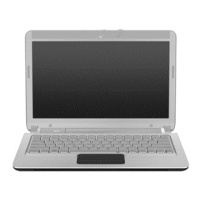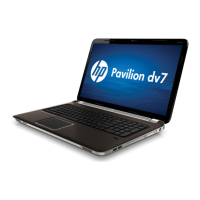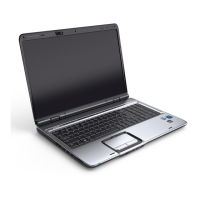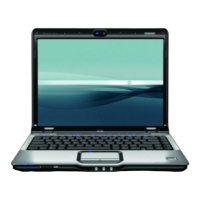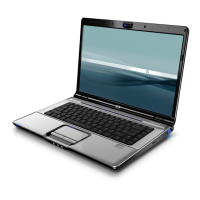
Do you have a question about the HP Pavilion dm1 and is the answer not in the manual?
| Display Size | 11.6 inches |
|---|---|
| Operating System | Windows 7 Home Premium |
| Resolution | 1366 x 768 |
| Wireless | 802.11 b/g/n |
| Bluetooth | Yes |
| Processor | AMD E-450 |
| RAM | 4 GB |
| Storage | 320 GB HDD |
| Weight | 1.6 kg |
| Graphics | AMD Radeon HD 6310 or AMD Radeon HD 6320 |
| Battery | 6-cell lithium-ion |
| Dimensions | 29.18 x 21.41 x 2.06 - 3.15 cm |
Identifies components of the computer display, including antennas, microphone, and webcam.
Details the power button and QuickWeb button functions and locations on the keyboard.
Explains the functions of the esc, fn, Windows logo, applications, and action keys.
Describes the power, mute, wireless, caps lock, and touchpad lights and their meanings.
Details the TouchPad components: light, on/off button, zone, and left/right buttons.
Identifies components located on the front of the computer, primarily the speakers.
Locates and describes ports and vents on the left side, including power, security, HDMI, and USB.
Identifies ports on the right side, including digital media slot, audio jacks, USB ports, monitor, and network jack.
Locates components on the bottom of the computer, including battery bay, SIM slot, and vents.
Explains the information found on the service label for ordering parts and support.
Provides an exploded view and list of major computer components and their part numbers.
Details the parts that make up the display assembly, including bezel, webcam, and panel.
Lists hard drives and solid-state drives, including specifications and spare part numbers.
Lists various miscellaneous parts like AC adapters, power cords, and screw kits with their part numbers.
Provides a cross-reference of part numbers to their corresponding descriptions and components.
Covers necessary tools, service considerations, and precautions before starting disassembly and reassembly.
Provides essential precautions for safely handling hard drives and other fragile storage components.
Explains electrostatic discharge (ESD) risks and methods to prevent damage to electronic components.
Details proper procedures for packaging and transporting equipment to prevent ESD damage.
Provides detailed steps for removing and replacing various computer components.
Explains how to locate and use information from the computer's service label for support.
Describes the computer feet, their locations, and the spare part number for replacement.
Details the removal and insertion procedures for the computer's battery.
Explains how to remove and insert the SIM card for WWAN modules on supported models.
Provides step-by-step instructions for removing and replacing the computer's display panel.
Details the procedure for removing and replacing the webcamera module.
Explains how to remove and replace the Wireless LAN (WLAN) module, including precautions.
Provides instructions for removing and replacing the Wireless WAN (WWAN) module on specific models.
Details the procedure for removing and replacing the Real-Time Clock (RTC) battery.
Covers the removal and installation process for the computer's hard drive.
Explains how to remove and install memory modules, including handling precautions.
Details the steps for removing and replacing the computer's keyboard.
Provides procedures for removing and replacing the entire display assembly.
Details the steps for removing and replacing the computer's top cover.
Explains the procedure for removing and replacing the computer's speakers.
Details the process for removing and replacing the TouchPad button board and its cable.
Provides instructions for removing and replacing the system board, including component transfer.
Explains how to remove and replace the power connector cable and its bracket.
Details the procedure for removing and replacing the computer's internal fan.
Covers the removal and installation of the heat sink, including thermal material handling.
Explains how to access and navigate the BIOS Setup Utility for system configuration.
Provides steps to enter the BIOS Setup Utility using keyboard commands.
Guides users on how to change the display language within the BIOS Setup Utility.
Details methods for navigating menus and selecting options within the BIOS Setup Utility.
Explains how to view system information, such as time, date, and identification details.
Guides on how to reset BIOS settings to their original factory default values.
Explains how to save or discard changes and exit the BIOS Setup Utility.
Provides information on obtaining and installing BIOS updates from the HP website.
Explains how to check the current system BIOS version for update compatibility.
Provides steps and precautions for downloading and installing BIOS updates.
Explains how to run diagnostic tests to check the computer's hardware functionality.
Lists the physical dimensions, weight, power, temperature, and altitude specifications for the computer.
Details the specifications for the 11.6-inch LED display, including dimensions, resolution, and brightness.
Provides detailed specifications for various hard drive capacities, including dimensions, transfer rates, and seek times.
Explains how to restore the system to its factory image using recovery media or partitions.
Guides on creating recovery discs or a recovery flash drive using HP Recovery Manager.
Details how to repair or restore the computer to its original factory state using Recovery Manager.
Explains how to restore the system from a dedicated recovery partition on the hard drive.
Provides steps for restoring the system using recovery discs or a recovery flash drive.
Modifies the boot order to enable booting from recovery discs or flash drives.
Emphasizes the importance of backing up data and outlines methods for doing so.
Explains how to create backups using the Windows Backup and Restore utility.
Details how to create and use system restore points to revert the system to a previous state.
Provides guidance on optimal times to create system restore points for system protection.
Provides step-by-step instructions for creating a system restore point.
Guides users on how to perform a system restore to a previous date and time.
Outlines general requirements for power cord sets applicable to all regions.
Lists specific accreditation agencies and notes for power cord sets in various countries.
